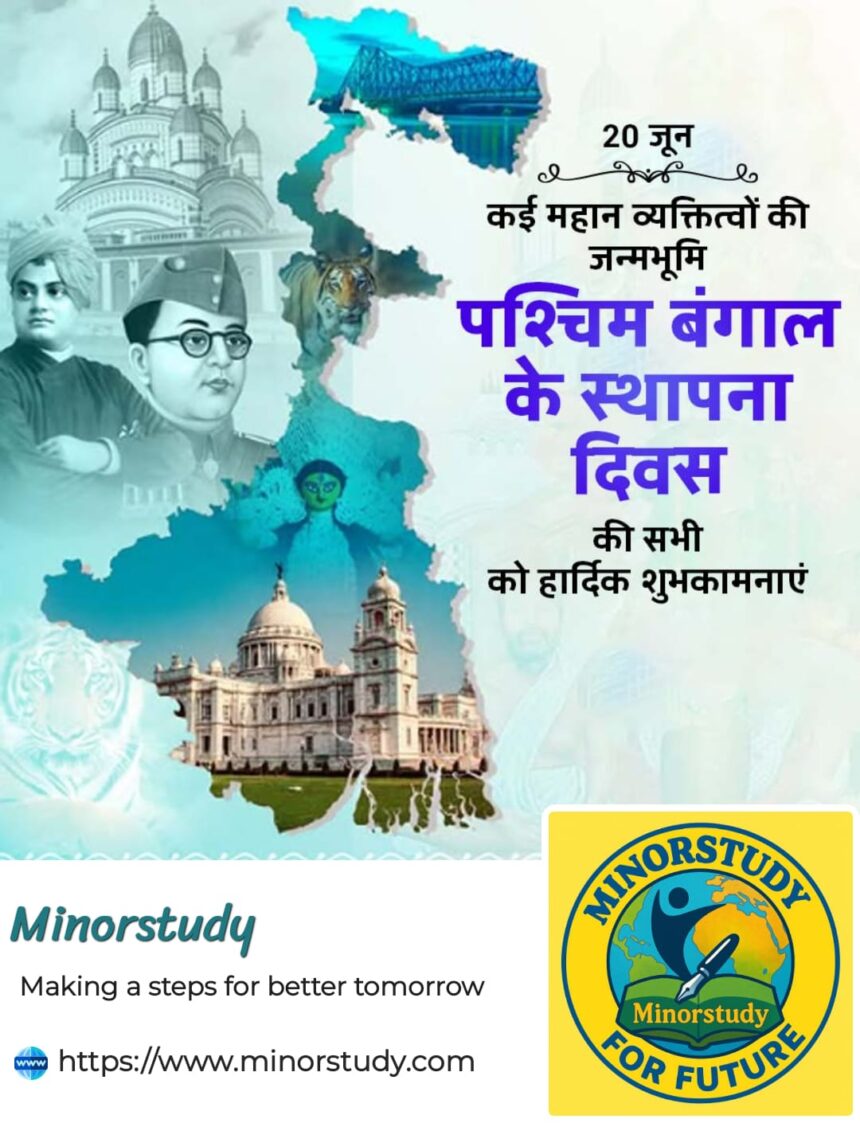West Bengal Foundation Day: History, Facts, Timeline & Its Lasting Significance
West Bengal, a culturally vibrant and historically rich state of India, observes West Bengal Foundation Day every year to mark a significant and somewhat painful chapter of Indian history. Unlike other state foundation days that are widely celebrated with pride, West Bengal’s origin story is embedded in the complex emotional aftermath of Partition, where division, displacement, and identity crisis deeply affected the region.
- 📜 History of West Bengal Foundation Day
- 🧾 Key Facts About West Bengal Foundation Day
- 🗓️ Timeline of Major Events Related to West Bengal Formation
- 💡 Significance of West Bengal Foundation Day
- 🧭 1. Historical Reminder
- 🧬 2. Cultural Assertion
- 🏛️ 3. Political Evolution
- 🌏 4. Geopolitical Importance
- 🧠 Frequently Asked Questions (FAQs)
- ❓ Why is West Bengal Foundation Day on 20th June?
- ❓ Is West Bengal Foundation Day celebrated officially?
- ❓ Why is there controversy around celebrating it?
- ❓ What was the role of the Bengal Legislative Assembly?
- ❓ How is West Bengal different from Bangladesh today?
- 🎉 Wishing on West Bengal Foundation Day
- 🌍 Why West Bengal Foundation Day Matters in Our Lives
- 🏘️ 1. For Local Communities
- 🎓 2. For Students and Scholars
- 🏙️ 3. For Daily Life
- 🏛️ 4. For National Unity
- 📌 Important Points to Remember
- 🧭 Conclusion: A Painful Past, a Proud Present
In this article, we explore everything about West Bengal Foundation Day — from its origin and timeline to its significance, societal impact, and why it’s still a controversial yet essential remembrance in today’s India.
📜 History of West Bengal Foundation Day
The story of West Bengal begins on 20th June 1947 — a date that remains etched in the memories of those affected by the brutal reality of Partition.
✅ Why was this date chosen?
The British Parliament’s Indian Independence Act of 1947 mandated the division of British India into two dominions — India and Pakistan. This led to the partition of Bengal into:
West Bengal (part of India)
East Bengal (later East Pakistan, now Bangladesh)
On 20th June 1947, the Bengal Legislative Assembly held a historic vote. It was decided that Bengal would be divided along religious lines. Hindu-majority areas would remain in India as West Bengal, while Muslim-majority areas would go to Pakistan as East Bengal.
This marked the formal foundation of West Bengal as a state of India.
🧾 Key Facts About West Bengal Foundation Day
| Fact Number | Key Detail |
|---|---|
| 1️⃣ | Date of Foundation: 20th June 1947 |
| 2️⃣ | Origin: Partition of Bengal during Indian Independence |
| 3️⃣ | Voted by: Bengal Legislative Assembly |
| 4️⃣ | State Formed: Hindu-majority districts joined India |
| 5️⃣ | Earlier Part of: Undivided Bengal Presidency under British rule |
| 6️⃣ | Present-Day Status: West Bengal is the 4th most populous Indian state |
| 7️⃣ | Language & Culture: Bengali language, Rabindranath Tagore’s legacy, Durga Puja traditions |
🗓️ Timeline of Major Events Related to West Bengal Formation
| Year | Event |
|---|---|
| 1757 | British East India Company gains control after the Battle of Plassey |
| 1905 | First Partition of Bengal (undone in 1911 due to protests) |
| 1947 | Final Partition and formal vote on 20th June |
| 1950 | India becomes a Republic; West Bengal integrated as a full state |
| 1956 | States Reorganization Act confirms state boundaries |
| 2001 | Calcutta renamed to Kolkata, reflecting Bengali identity |
| 2011 | Mamata Banerjee becomes first female CM of West Bengal |
💡 Significance of West Bengal Foundation Day
Despite its tragic origin, Foundation Day carries multi-layered significance:
🧭 1. Historical Reminder
It’s a reminder of one of the most traumatic transitions in modern history — Partition. Families were uprooted, millions migrated, and countless lives were lost.
🧬 2. Cultural Assertion
The formation of West Bengal also cemented the region’s identity as a cultural powerhouse. Home to Rabindranath Tagore, Swami Vivekananda, and Satyajit Ray, Bengal became a symbol of intellect, art, and resistance.
🏛️ 3. Political Evolution
The day also reminds us of Bengal’s shifting political ideologies — from British rule, Congress dominance, decades of Communist governance, to the Trinamool era.
🌏 4. Geopolitical Importance
West Bengal’s borders with Bangladesh, its port in Kolkata, and gateway to Northeast India make it geopolitically crucial.
🧠 Frequently Asked Questions (FAQs)
❓ Why is West Bengal Foundation Day on 20th June?
Because on 20th June 1947, the Bengal Legislative Assembly voted for the partition of Bengal, leading to the creation of West Bengal in India and East Bengal in Pakistan.
❓ Is West Bengal Foundation Day celebrated officially?
Not in a grand ceremonial way. Unlike other Indian states, West Bengal does not officially celebrate this day due to its painful association with Partition.
❓ Why is there controversy around celebrating it?
Many see it as a reminder of the trauma of Partition, especially for those whose families were displaced or lost during the migration. Others believe it should be marked as a day of reflection rather than celebration.
❓ What was the role of the Bengal Legislative Assembly?
The Assembly voted to divide Bengal, a move that determined the political, religious, and geographical fate of millions.
❓ How is West Bengal different from Bangladesh today?
Though they share language and culture, West Bengal is part of secular India, while Bangladesh is an independent Muslim-majority nation, which broke from Pakistan in 1971.

🎉 Wishing on West Bengal Foundation Day
Although not widely celebrated, you can wish your Bengali friends and community with respectful, reflective messages:
🕊️ “On West Bengal Foundation Day, let’s remember our roots, honor our cultural pride, and commit to unity in diversity.”
📚 “Wishing strength and pride to all Bengalis on this day of remembrance and reflection.”
🎨 “May the rich heritage of West Bengal continue to inspire generations. Happy Foundation Day!”
🌍 Why West Bengal Foundation Day Matters in Our Lives
🏘️ 1. For Local Communities
It’s an opportunity to remember the struggles of refugees and immigrants who rebuilt their lives from scratch.
🎓 2. For Students and Scholars
West Bengal’s creation is a critical chapter in Partition Studies, Colonial History, and Indian political evolution.
🏙️ 3. For Daily Life
The socio-political structure, language policies, and cultural festivals in West Bengal today are shaped by that decision in 1947.
🏛️ 4. For National Unity
It reminds us that state identities in India are often tied with emotional, historical legacies, not just geography.
📌 Important Points to Remember
Date: 20th June every year
Origin: Decision of Partition in 1947
Key Emotion: Remembrance over celebration
Culture: Rich Bengali heritage thrives despite historical scars
Current Status: One of India’s most vibrant states economically and culturally
🧭 Conclusion: A Painful Past, a Proud Present
West Bengal Foundation Day may not be marked by fireworks or flag hoisting, but its emotional intensity and historical depth make it an unforgettable day of reflection. It invites us to acknowledge the trauma of Partition, honor the resilience of survivors, and celebrate the incredible journey Bengal has taken in art, politics, education, and society.
Even today, the spirit of West Bengal lies not just in the landmarks of Kolkata, but in the hearts of those who carry its legacy — through Rabindra Sangeet, Durga Puja, political activism, and intellectual discourse.
Let us not forget the lessons of history. West Bengal’s Foundation Day is not just about its borders — it’s about its soul.








